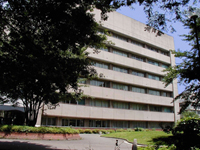Overview
National Institute of Neuroscience: An overview

The National Institute of Neuroscience (NIN) is one of the research units in National Center of Neurology and Psychiatry (NCNP). The mission of NCNP is to conduct research and provide medical care for patients with brain or muscular disorders. As part of NCNP, NIN conducts biomedical research in three research buildings and two animal experimentation facilities. In NIN, there are seven departments for basic neuroscience research and seven departments for clinically oriented research, as well as administration sections for animal experimentation and radioisotope-assisted experiments. In the basic research departments, scientists are actively undertaking research by applying the methodology of molecular biology, molecular genetics, molecular physiology, immunology, morphology, biochemistry and developmental biology. Clinically oriented departments are engaged in research related to neurological diseases, muscular diseases, psychiatric diseases and developmental disorders. Collaborative studies with many domestic and foreign institutes are productively running and many researchers from different laboratories in Japan and around the world actively join NIN.
Greeting
Director’s message
At the global forefront
As one division of the National Center of Neurology and Psychiatry (NCNP), the National Institute of Neuroscience collaborates with NCNP hospitals and the National Institute of Mental Health to elucidate the pathology and causes of psychiatric, neurological, muscular, and developmental disorders, as well as develop methods to prevent and treat them. The National Institute of Neuroscience, comprising 14 departments and 3 administration offices, focuses primarily on biological research that ranges from basic research to clinical studies.
One main strength of the National Institute of Neuroscience is that basic research on neurology is conducted in an environment where clinical research is also conducted. As such, basic research findings can have a more direct impact, promoting health among Japanese citizens throughout the nation. Affiliated researchers include numerous professionals trained in healthcare fields such as medicine and pharmacology, but also a diverse array of highly accomplished researchers in physics, engineering, and agricultural sciences. This interdisciplinary composition represents yet another strength, as the diversity allows for branching out in numerous directions in research and development. As the latest progress in science and technology is incorporated rapidly into research, the stage is set for cutting edge results to be produced.
Another strength worth noting is that the National Institute of Neuroscience invests heavily in the career paths of young researchers who will be bearing the next generation. NCNP first built up the “Research Fellow” system in Japan, enabling Ph.D. researchers to conduct stable research activities. Currently, up to 45 research fellows at the National Institute of Neuroscience are actively taking advantage of this system. Participation from other young researchers is also evident. These include special researchers of the Japanese Society for the Promotion of Science, research fellows, research scholars, and visiting scientists, boasting a total of over 200 individuals.
The National Institute of Neuroscience also functions as a graduate university. Accredited graduate programs have been established in partnership with the Faculty of Science and Engineering of Waseda University beginning in fiscal year 2004, Tokyo Medical and Dental University in 2006, Yamanashi University in 2009, Chiba University in 2010, and Tokyo University of Agriculture and Technology in 2013. In addition to Japanese researchers, the National Institute of Neuroscience hosts exchange students and researchers from all over the world including those from the US, Germany, France, China, Korea, and the Philippines. Collaborative research is also being conducted with overseas research facilities including Johns Hopkins University, Harvard University, Max Planck Research Institute, the Pasteur Institute, Pierre and Marie Curie University, and the University of Melbourne.
The history of the National Institute of Neuroscience began in April 1978 with the establishment of the Neurological Research Center as part of the National Musashi Sanatorium. At that time, there were 8 departments in 16 rooms. However, by October 1986, with the establishment of the (then) Neurological Research Center and National Mental Health Laboratory, it was renamed the National Institute of Neuroscience, expanding to 14 departments with 35 rooms and 2 administration offices. In April 2010, with the incorporation of the NCNP as an independent administrative corporation, the name was changed once again, to the National Institute of Neuroscience, NCNP. In April 2015, the NCNP was included in the National Research and Development Agency. Thanks to the constant effort and hard work of those at the NCNP, the Center continued to develop steadily, and was selected as a site for the Center of Excellence (COE) Development Program in 1995. In the 40 years since its initial establishment as the Neurological Research Center, the Institute has become a domestic research hub with the greatest activity in neuroscience and neurological diseases, and continues to battle these at the global forefront.
Research facilities of the NCNP comprise a main building along with Buildings 2 and 3, and the National Institute of Neuroscience and National Institute of Mental Health are connected with shared space between the two. The National Institute of Neuroscience also has an animal care facility for small experimental animals, comprehensive research and imaging analysis facilities for experimental animals, and offers a setting where comprehensive research can be conducted. In this cutting-edge environment, each researcher is pioneering new areas in their respective fields, with daily scientific dialogue with others. All work together to push the research forward.
Let me conclude with a simple introduction of myself. After studying neurology, I continued on with research in the field of neuropathology, clarifying the pathological state of neurological diseases and developing treatments for these. Alzheimer’s dementia and Parkinson’s disease are just two of many neurodegenerative diseases affecting increasingly more individuals. Given the urgent need for research aimed at developing preventive measures and treatments for these diseases, I am excited for the opportunity to work toward this objective at the National Institute of Neuroscience. I will be continuing with my research studies in the Department of Neuropathology of the University of Tokyo, but I will give everything I have to also work toward the development of the National Institute of Neuroscience.
Japanese citizens eagerly await good news from us concerning treatments and cures for neurological, psychiatric, muscular, and developmental disorders. I am honored to join the tireless efforts of those working at the National Institute of Neuroscience so that one day we may deliver such good news. Any opinions, criticisms, feedback, or support concerning the activities of the Institute are always welcome.
In addition to offering my sincere gratitude to the many who have instructed and taught me along the way, I also wish to take this moment to ask for their continued support of the National Institute of Neuroscience.
April 2020
National Center of Neurology and Psychiatry
Takeshi Iwatsubo, Director of the National Institute of Neuroscience
History
The National Institute of Neuroscience (NIN) was originally founded as a research unit of the National Musashi Hospital by the Ministry of Health and Welfare in 1978. This research institute is devoted to elucidate the pathogenesis and onset mechanisms of various diseases in the fields of neurology and biological psychiatry, and to establish effective treatments and prevention strategies for these medical conditions. In 1986, NIN became one of the research units of the National Center of Neurology and psychiatry (NCNP). In 2010, NCNP was reorganized as an independent administrative agency and in 2015 became a National Research and Development Agency. Now, NIN consists of 14 research and 3 administrative departments. The activity of the research departments mainly concerns muscular dystrophies, inherited metabolic diseases, degenerative neurological diseases, mental and cortical function disorders and developmental disorders. The administrative departments assist the proper utilization of radioisotopes, rodents and primates for research purposes.
The Institution of Research Institute
Main building
Main building

Two Photon Laser Confocal Microscope

LC MS/MS

Building ll
Building ll

EM Tecnai G

EM Tecnai G

Building lll
Building lll

Building lll

Building lll

Small Animal Research Facility
Small Animal Research Facility

Entrance

Cryo-storage system for mouse embryos

Embryo manipulation room

General Animal Research Facility
General Animal Research Facility

MRI for animal experiments

X-ray irradiation apparatus

Fluorescence-Activated Cell Sorter

Each Department
| Director General | tel | fax |
|---|---|---|
| Takeshi Iwatsubo | 81-42-341-2711 |
| Dept. | tel | fax |
|---|---|---|
| Department of Neuromuscular Research | 81-42-346-1712 | 81-42-346-1742 |
| Department of Mental Retardation and Birth Defect Research | 81-42-346-1713 | 81-42-346-1743 |
| Department of Mental Disorder Research | 81-42-346-1714 | 81-42-346-1744 |
| Department of Degenerative Neurological Diseases | 81-42-346-1715 | 81-42-346-1745 |
| Department of Peripheral Nervous System Research | 81-42-346-1716 | 81-42-346-1746 |
| Department of Demyelinating Disease and Aging | 81-42-346-1717 | 81-42-346-1747 |
| Department of Functional Brain Research | 81-42-346-1718 | 81-42-346-1748 |
| Department of Biochemistry and Cellular Biology | 81-42-346-1722 | 81-42-346-1752 |
| Department of Ultrastructural Research | 81-42-346-1719 | 81-42-346-1749 |
| Department of Molecular Therapy | 81-42-346-1720 | 81-42-346-1750 |
| Department of Immunology | 81-42-346-1723 | 81-42-346-1753 |
| Department of Molecular Pharmacology | 81-42-346-1725 | 81-42-346-1755 |
| Department of Neurophysiology | 81-42-346-1724 | 81-42-346-1754 |
| Division of Laboratory Animals Resources | 81-42-346-1417 | 81-42-346-1418 |
| Division of Radiation Protection | 81-42-346-1726 | 81-42-346-1756 |

